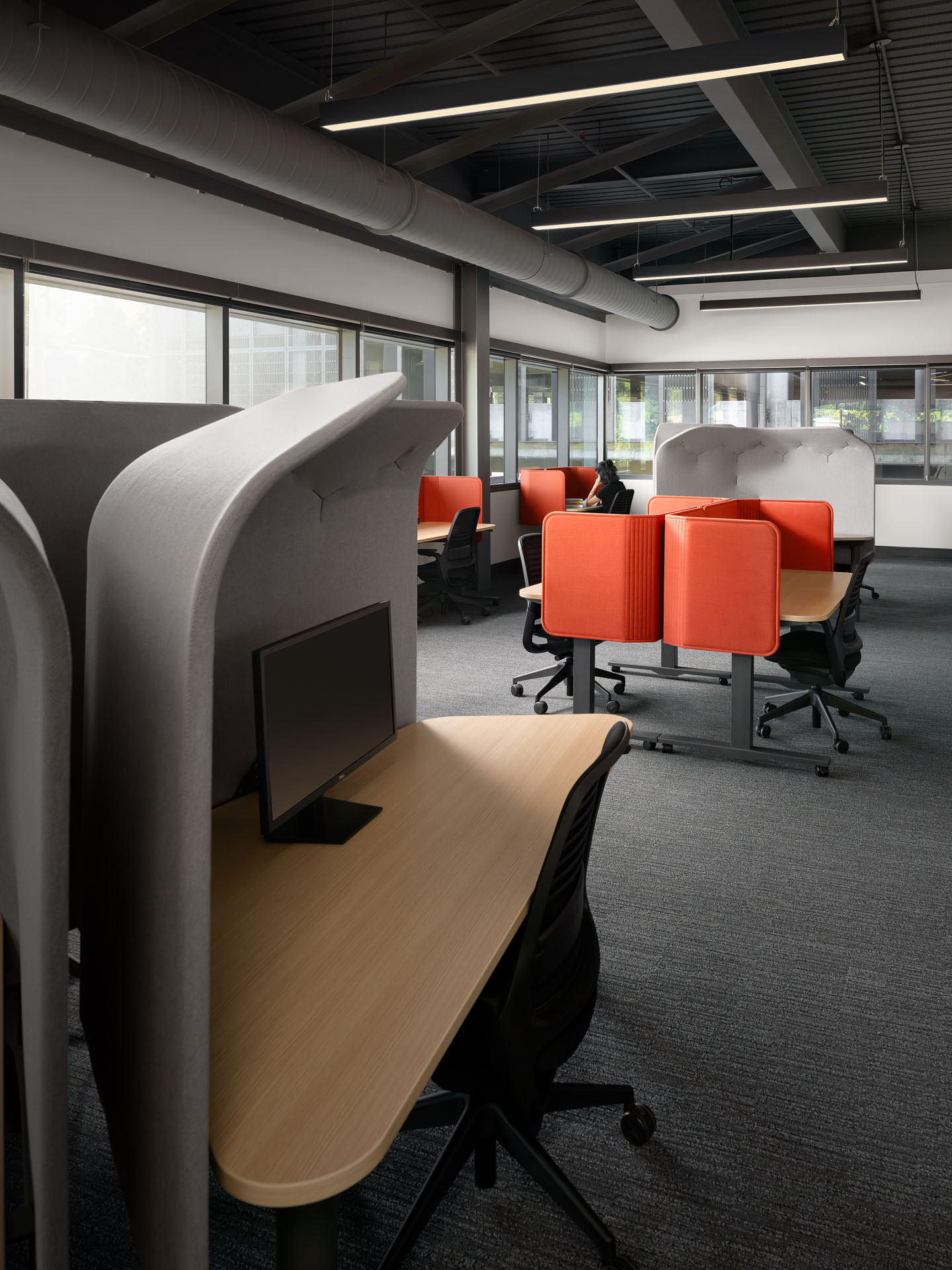Cameras and Lenses I Use for Architectural Photography

As an architectural photographer, I rely on specialized equipment to produce commercial-quality images. Achieving impactful results requires both technical precision and understanding client needs. This article explores the camera systems and lenses I've found essential for professional architectural photography.
Cameras I Use for Architectural Photography
When choosing a camera for architectural photography, I consider resolution, dynamic range, lens options, ease of use, size, weight, and cost. Here are three different systems I have used, each offering unique advantages for architectural work.
Fuji GFX 100mp Series, Medium Format Digital Cameras
The Fuji GFX 100mp series features 102-megapixel medium format sensors, 1.7x larger than full-frame sensors. Their exceptional image quality makes them ideal for architectural and commercial photography.

PROS
- Canon and Nikon tilt-shift lenses can be adapted for use with the GFX
- Tethering with Capture One software for
- high resolution previews to show clients
- on site cropping, color, exposure, and distortion correction
- confirmation that you have your shot before moving on to the next one
- The versatility of a 102 megapixel sensor makes it possible to crop significantly when needed– e.g. a 18”x12” magazine spread printed at 300dpi requires less than ¼ of the overall sensor area
- The GFX is about the same size and weight as full frame mirrorless cameras
- The GFX can be used as a “digital back” on digital view cameras like the Cambo Actus and Arca Swiss F-Line or M-Line
- Built-in mechanical shutter compatible with flash lighting
- Can be triggered via remote
- Full sensor and 35mm crop modes
CONS
- Limited native tilt-shift lens options compared to full frame camera systems
- Adapted wide angle tilt-shift lenses like Canon’s TS-E 17mm and TS-E 24mm II struggle to resolve the level of detail available when using the full 102 megapixel medium format sensor
The versatility of the GFX system stems largely from its compatibility with both adapted and native tilt-shift lenses, which we'll explore in the lens section.
Cambo Actus, Digital View Camera
The Cambo Actus offers the perspective control and movements of a traditional 4x5 view camera in a compact, portable package. This system allows adjustments for perspective corrections without the bulk of larger view cameras.

PROS
- Compatible with the Fuji GFX 100mp series and full frame digital cameras
- Full range of view camera movements– e.g. vertical rise and fall, horizontal shift, tilt, and swing
- Lens remains stationary, eliminating parallax issues when stitching images
- Compatible with a wide range of lenses
- Any lens that is compatible with the Actus becomes a tilt-shift lens
- Compact and portable
- Fun to use
CONS
- Limited wide-angle lens options for GFX and full frame camera systems
- The GFX/Cambo Actus combination is not compatible with Canon TS-E or Nikon PC lenses
The Cambo Actus initially presented a challenge due to its incompatibility with Canon and Nikon perspective correction lenses. Two developments changed my assessment: finding a well-priced Actus that included the Cambo Actar 35mm lens, and Cambo's announcement of their new Actar 20mm lens (a modified Laowa 20mm Zero-D Shift Lens).
These professional-quality wide angle options made the Actus viable for architectural work with the GFX system.
Digital Back and Technical Camera
I've worked with different digital back and technical camera combinations for architectural photography. My experience includes the Phase One IQ4 150, and currently, I use the Hasselblad CFV 100C.
These digital backs deliver exceptional image quality with their high-resolution sensors, extensive dynamic range, and advanced features. Their non-recessed sensor planes allow use of the finest wide angle lenses available for architectural photography.
For technical cameras, I've moved from the Cambo WRS 1600 to the Arca Swiss Rm3di. Both are precision instruments that mount digital backs on one side and lenses on the other, keeping the lens stationary while allowing precise horizontal and vertical movements of the sensor plane.

PROS
- Exceptional resolution and dynamic range
- Compatible with high-quality lenses from Schneider and Rodenstock
- Rigid construction
- Panorama stitching with no parallax error
- Compatible with wide angle lenses made specifically for architectural photography
- Precise X/Y camera movements
- Surprisingly compact
- Fun to use
CONS
- Cost-prohibitive
- Schneider lenses are no longer manufactured and difficult to find
- Some Rodenstock lenses require software to fix lens distortion
- Digital backs have limited flash-sync capabilities due to the lack of a built-in shutter
Technical camera systems excel at exterior photography and available-light interior work. Their methodical process and precise movements deliver exceptional results in these situations. While my experience has been primarily with traditional technical cameras, it's worth noting that newer systems like the Phase One XT with X Shutter lenses offer flash synchronization similar to modern digital cameras.
For more information about technical cameras, visit the getdpi.com forum or read Dave Chew's in-depth article, Field Techniques for Technical Cameras .
Lenses I Use for Architectural Photography
The performance of any camera system depends heavily on lens selection. Architectural photography requires lenses that minimize distortion, enable perspective correction, and maintain high image quality. In-camera adjustments are preferable to post-processing corrections. Here's my experience with lenses across these different systems.
Tilt-Shift Lenses for Full Frame Digital Cameras
Canon and Nikon tilt-shift lenses are industry standards for their flexibility in perspective control. When paired with Fuji GFX 100mp series cameras, these lenses deliver professional results, particularly in the GFX's crop mode.
- Canon TS-E 17mm
- Canon TS-E 24mm II
- Canon TS-E 50mm Macro
- Canon TS-E 90mm Macro


PROS
- Readily available
- Extreme wide angle option
- Image circle is large enough for movements on medium format sensors
- Can be adapted to GFX 100mp series
- Professional quality
CONS
- Can only shift in one direction– vertical, horizontal, or diagonal
- Lower image quality than technical camera lenses
- Gap between 24mm and 50mm focal length
The 50mm and 90mm lenses perform excellently on the full medium format sensor, while the older 17mm and 24mm designs show corner weakness due to their original design for lower resolution 35mm cameras. A notable gap exists between the 24mm and 50mm focal lengths in Canon's lineup. For years, architectural photographers have been wishing for this gap to be filled.
Tilt-Shift Lenses for Medium Format Digital Cameras
The introduction of native tilt-shift lenses for the GFX system marks a significant advancement in medium format architectural photography. These purpose-built lenses complement the existing adapted tilt-shift options while offering unique advantages for GFX system users.
- Fujinon GF 30mm f/5.6 T/S
- Fujinon GF 110mm f/5.6 T/S



PROS
- Direct native mount eliminates the need for adapters
- Lens metadata includes shift information for precise adjustments
- Automatic lens corrections in Capture One streamline the post-processing workflow
- Exceptional image quality
- Impressive 15mm shift capability in any direction while maintaining edge-to-edge sharpness
- The 30mm's tripod foot maintains lens position, eliminating parallax issues when stitching images
CONS
- Higher investment cost compared to adapted tilt-shift lenses
- Larger physical size and weight
- Automatic lens corrections currently limited to Capture One software
- Limited focal length options (30mm and 110mm) compared to Canon or Nikon tilt-shift lens lineups
The Fujinon tilt-shift lenses represent a significant step forward in medium format architectural photography. Their native mount, automated features, and exceptional image quality make them powerful tools for professional architectural work, despite their premium price point and current limitations in focal length options.
View Camera Lenses for the Cambo Actus
The Cambo Actus digital view camera is highly versatile, capable of adapting a wide range of lenses . While options like Mamiya G and Mamiya N lenses perform well for architectural photography, they require irreversible modifications. The lenses in the following list offer a more practical choice for many photographers, as they avoid these alterations.
- Cambo Actar 20mm (Laowa 20mm f/4 Zero-D Shift - Retrofit)
- Cambo Actar 35mm (Contax 645 Distagon T* 3.5/35 - Retrofit)
- SMC Pentax 67 55mm F4 (w/Pentax Adapter 645 for 67 Lens)
- Pentax 645 75mm
- Schneider APO-Digitar 90mm


PROS
- 35mm focal length is available
- Can be used with the Cambo Actus and Fuji GFX 100mp series cameras
- Large image circle that allows significant camera movements, even on the GFX’s medium format sensor
- Manual aperture control
- Very low distortion
- Professional quality
- Apart from the Actar 35mm, these lenses are relatively affordable and easy to find
CONS
- Cambo Actar 35mm requires software lens profiles to control distortion
- Like Canon TS-E lenses, these lenses do not have the same resolving power as technical camera lenses
- Unless you can track down a used Actar 35mm, your only option is to buy a used Contax 645 Distagon T* 3.5/35 and pay for a retrofit through Cambo, which adds extra hassle and expense
For the critical 35mm focal length, I prefer the Actar 35mm over the Pentax 645 35mm. While both lenses offer sufficient image circle for movements, the Actar 35mm's built-in Capture One profiles better address distortion correction.
Technical Camera Lenses
The Schneider-Kreuznach APO Digitar series is known for minimal distortion, making it ideal for architectural photography without extensive post-processing. The Rodenstock HR Digaron series offers exceptional sharpness and large image circles, though some focal lengths require manual distortion correction.
While the Phase One XT system can automatically record movements for lens corrections in Capture One software, this feature isn't available when using other digital backs like the Hasselblad CFV 100C. Many technical camera lenses also require LCC (Lens Cast Calibration) files—reference images of a uniformly lit white surface that allow software to correct for vignetting and color cast issues.
Over the years, my lens choices have evolved based on both technical requirements and practical experience with different systems.
Lenses I Have Used Previously:
- Schneider 28mm f/5.6 Super Digitar XL*
- Schneider 43mm f/5.6 Apo-Digitar XL
- Schneider Apo-Digitar 60mm f/5.6 XL
- Schneider 180mm f/5.6 Apo Digitar T
- Rodenstock HR Digaron-S 23mm f/5.6**
- Rodenstock HR Digaron-W 32mm f/4.0**
- Rodenstock HR Digaron-SW 90mm f/5.6**
Lenses I Currently Use:
- Schneider 35mm f/5.6 Apo-Digitar XL***
- Rodenstock HR Digaron-W 50mm f/4.0****
- Rodenstock HR Digaron-W 70mm f/5.6
- Schneider 100mm f/5.6 APO-Digitar N
- Schneider 120mm f/5.6 APO-Digitar ASPH
- Schneider 150mm f/5.6 APO-Digitar N
* The Schneider 28XL, while an engineering marvel for its ultra-wide angle and near-zero distortion, became challenging to use as digital back technology evolved, primarily due to vignetting and color cast issues with modern sensors
** Require software correction for distortion
*** Requires LCC calibration file for vignetting correction
**** When using extreme shifts (15mm or more), create an LCC calibration file to address vignetting. Distortion may also be present and require software correction


PROS
- Incredible sharpness and clarity
- Small and lightweight
- Large image circles for camera movements
- Ability to stitch multiple shots into supersized panoramic images with edge to edge sharpness
- Satisfying to work with
CONS
- Difficult to find because they are no longer manufactured
- Expensive
- 43mm and wider require center filters to help even out light fall-off
- 60mm and wider require LCC capture to fix vignetting and lens cast
These technical camera lenses excel at exterior photography and available-light interior work. Their methodical process and precise movements, combined with the exceptional image quality, deliver superior results in these situations. While newer systems like the Phase One XT with X Shutter lenses offer flash synchronization similar to modern digital cameras, I find the GFX with tilt-shift lenses more practical for flash-lit interior work.
Conclusion
Each system described here offers distinct advantages for architectural photography. The GFX 100mp series excels with its native tilt-shift lenses and adapted options, particularly for interior work requiring flash. Digital view cameras like the Actus provide traditional movements in a modern package, though lens options for architectural work are somewhat limited when paired with a GFX camera. Technical cameras with their precise movements and high-resolution digital backs deliver exceptional results for exterior photography and available-light situations, though they require careful consideration of lens choice and correction workflows.
Your selection of camera system and lenses should align with your specific projects, working style, and client needs. Focus on finding tools that not only deliver the image quality you require but also support an efficient workflow for your particular applications.

 Fashion Gray
Fashion Gray Crimson
Crimson Deep Yellow
Deep Yellow Tech Green
Tech Green Black
Black Purple
Purple Blue Jean
Blue Jean Blue Jay
Blue Jay Orange
Orange Primary Red
Primary Red Super White
Super White